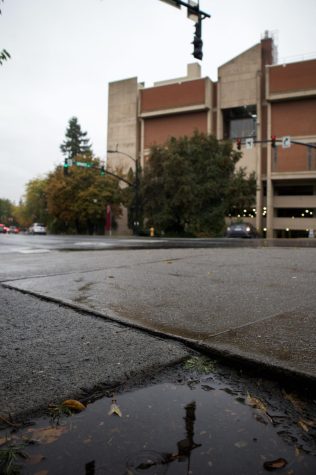Officials say preventing future water main breaks is difficult
Breaks are hard to predict, but Public Works will monitor flooding, causes
A chilled-water pipe broke around 2:30 p.m. and flooded the area.
October 27, 2022
Pullman and WSU faced spontaneous flooding during the past two months, and City of Pullman officials said Public works will monitor the causes of these issues in the future.
The last major water main break occurred at 2 p.m. on Sept. 17 on Grand and Center streets, said Matt Young, communications coordinator for the City of Pullman.
“The one [flood] on the WSU campus … that one actually wasn’t a water main break, that was actually a chiller line that had leaked out into the road,” he said. “WSU had their own personnel on scene to kinda take care of that one.”
He said the water main breaks were unrelated to each other and could have had a number of different causes, including the pipes’ installations, rocks and objects near the pipes, the freezing and thawing of pipes, and vibration from both traffic and utility work in the area.
Young said that a lot of these floods are irregular and hard to predict, so gauging future preventative measures can be very difficult.
“We do monitor these events … they [Public Works] will monitor these events to make sure that they have knowledge of why it happened and what happened and when and where,” he said. “They’ll take a look at the different conditions under which this may have occurred so that they can keep an eye out for any repairs or maintenance that needs to be done in the future.”
He said when the city received reports of flooding, they sent personnel down as quickly as possible to resolve the problem.
“We are really requesting people sign up for emergency notifications from the city by Everbridge,” Young said. “When there are huge emergencies or notable emergencies for the city, we’ll be able to push out messages on that system.”

Water lines ruptured on Northeast Stadium and Grimes way on Oct. 13.
It can reach you via text, via email or phone call. It will keep trying all these various contact methods down the line until it registers that you received the message, he said.
“So that happened at 2, about 3 hours later I was able to get out the first social media message because I had just gotten details about what was going on so we were able to get that out to the public,” Young said.
He said the City issued an advisory on water safety Saturday night, and that on Monday, their operations team was sent out to check the water samples, which came back all clear and safe to use on Tuesday, prompting the city to quickly send out a notification to Pullman residents.
“In the Daisy and Grand one [flood], that was simply a service line, they just had to kind of excavate a little bit, patch it up and then they’ll pave over that area again, patch that area, and then essentially traffic can continue at that time,” Young said.
Dr. Raelynn Farnsworth, professor and chief medical officer at the WSU Veterinary Teaching Hospital, witnessed the chiller line leak firsthand.
She said the flood blocked the entrance and exit of the hospital, and while individuals were able to get in and out, the flooding made some apprehensive about doing so.
“In the hospital, we need that chilled water for our air conditioning … but more importantly, we need it to run our MRI and our linear accelerator, so we needed it for key equipment in the hospital,” Farnsworth said. “Luckily we were done using that equipment for the day. We then needed to know what was going to happen the next day for our patients.”
She said the flood resolved quickly and was notified once Facilities shut off the water and that the flood was completely cleaned up by 6 p.m. on Oct. 13.


















